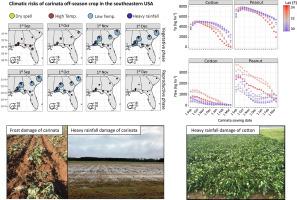Agricultural Systems ( IF 6.1 ) Pub Date : 2021-12-09 , DOI: 10.1016/j.agsy.2021.103344 Rogério de Souza Nóia Júnior 1 , Clyde W. Fraisse 2 , Mahesh Bashyal 3 , Michael J. Mulvaney 3 , Ramdeo Seepaul 4 , Mauricio A. Zientarski Karrei 2 , Joseph Enye Iboyi 3 , Daniel Perondi 2 , Vinicius Andrei Cerbaro 2 , Kenneth J. Boote 2

|
CONTEXT
Brassica carinata is usually grown in a double-cropping system with cotton and peanut in southeastern USA. One challenge related to this system is to define the best sowing dates to minimize the climatic risk and improve the chances for increased farmers' profitability.
OBJECTIVE
The objective was to determine the best sowing dates for carinata-cotton and carinata-peanut double-cropping systems in different locations of the southeastern USA.
METHODS
A calibrated crop simulation DSSAT model was used to simulate carinata life cycle and cotton and peanut yields for 9 locations in 4 states, with carinata sowing dates ranging from early September to March using 38 years of weather data (1981–2018), assuming that cotton and peanut sowing occurred immediately after the carinata harvest.
RESULTS AND CONCLUSIONS
Results indicated that the optimal sowing date varied according to location. For Shorter, AL, Midville, GA, and Florence, SC, the occurrence of extreme weather events during carinata cycle were minimized, and the summer crop yields were the highest when carinata was sown at the end of October. For Fairhope, AL, Jay, and Quincy, FL, results showed that carinata sowing must occur in early November to minimize the climatic risks of a double-cropping system. For Live Oak and Citra, FL, carinata sowing is recommended for mid- to late-November. Advancing carinata sowing to September resulted in an increased number of low temperature (LT) events during the carinata reproductive phase. The delay in carinata sowing to January or later exposed carinata crop to a larger number of High Temperature (HT), and considerably reduced the yield potential of the peanut and cotton summer crops.
SIGNIFICANCE
Our results quantified the climatic risks to the off-season carinata crop itself and to the subsequent summer crop, contributing to the sustainable expansion and commercial production of carinata in the southeastern USA.
中文翻译:

芸苔作为美国东南部的淡季作物:根据气候风险和对夏季作物产量的潜在影响确定最佳播种日期
语境
Brassica carinata通常在美国东南部的棉花和花生双作系统中种植。与该系统相关的一个挑战是确定最佳播种日期,以最大限度地降低气候风险并增加农民盈利的机会。
客观的
目的是确定美国东南部不同地区carinata-cotton和carinata-peanut双作系统的最佳播种日期。
方法
使用校准的作物模拟 DSSAT 模型模拟 4 个州 9 个地点的 carinata 生命周期和棉花和花生产量,carinata 播种日期从 9 月初到 3 月使用 38 年的天气数据(1981-2018),假设棉花花生在收获后立即播种。
结果和结论
结果表明,最佳播种日期因地点而异。对于Shorter, AL, Midville, GA 和Florence, SC,carinata 周期中极端天气事件的发生最小化,10 月底播种carinata 时夏季作物产量最高。对于费尔霍普、阿拉巴马州、杰伊和佛罗里达州昆西来说,结果表明必须在 11 月初播种carinata,以最大限度地减少双作系统的气候风险。对于 Live Oak 和 Citra, FL,建议在 11 月中下旬播种carinata。将carinata 播种提前到9 月导致carinata 繁殖阶段的低温(LT) 事件数量增加。将carinata 播种推迟到1 月或更晚,使carinata 作物暴露在大量高温(HT)中,
意义
我们的结果量化了淡季 carinata 作物本身和随后的夏季作物的气候风险,有助于美国东南部 carinata 的可持续扩张和商业生产。











































 京公网安备 11010802027423号
京公网安备 11010802027423号